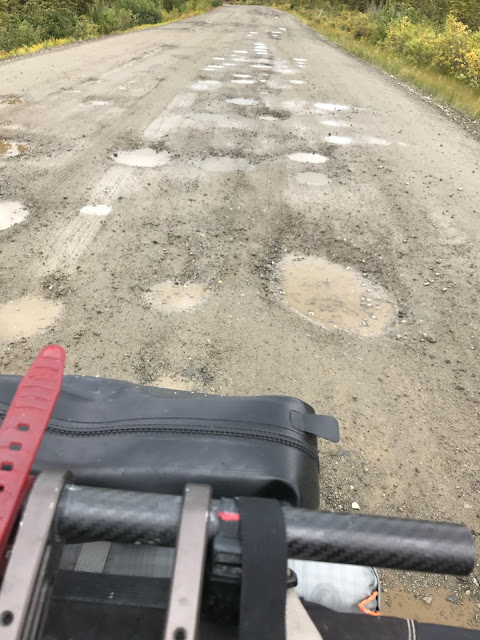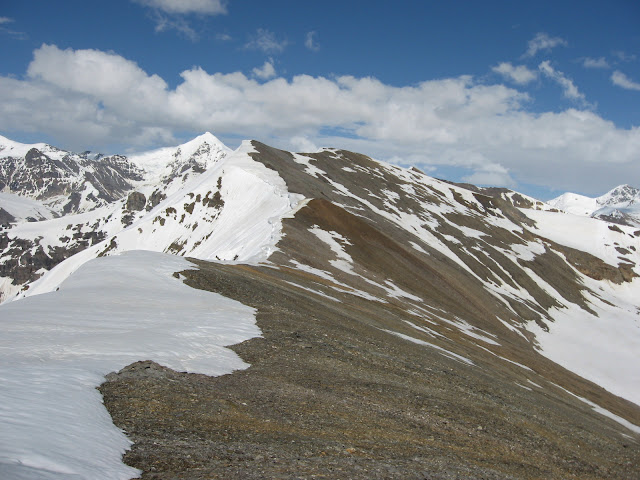I love the Denali Highway. Big open vistas, mountains, glaciers, good gravel and usually not much traffic.
The weather looked to be good for the weekend. Even though I was tired and should have stayed home, I decided to do another trip. I wanted to get out while the weather was still good and the Denali Highway was calling my name. I would go alone since Eric already had plans. I really enjoy solo time in the wilderness so I was perfectly fine with this. In addition, it really wouldn't be wilderness as hunting season had started and there were sure to be lots of hunters on the Denali Highway on a nice weekend.
I snagged a campsite in Denali National Park for Friday night. I packed and had everything in my car so that I could head down right from work. I made it to the Savage River Campground with time for dinner and a hike before bedtime.
 |
| Evening hike along the Savage River |
I was up and moving Saturday morning by 5 AM as I had to drive 30 miles to Cantwell before starting my adventure. I had an ambitious plan to bike 100 miles to the top of Maclaren summit and camp, then turn around early Sunday morning and bike back. Then drive home, unpack and get some sleep before work on Monday. It would be a very full weekend.
 |
| Early morning alpine glow on Denali |
 |
| 6 AM sunrise driving out of Denali National Park - It pays to get up early |
Why did I want to go big like this? I’m not training for anything at this point. Was I trying to prove something? Did I just want to see a lot of country or was it something more?
I pondered this while biking. Many athletes do endurance training to help with their anxiety or depression. Luckily, I have neither. I’m fairly even-keeled, mostly optimistic and only need a short, hard ride to deal with any stress I may be feeling. I have a reputation for going long, so do I feel I have to do something epic to keep up that reputation? Do I do it for bragging rights? It feels good when people say I’m an inspiration to them but it’s also embarrassing. I’m not doing anything special, I just keep turning the pedals. And to be honest, just as many people think I’m crazy as inspiring. Do I even care what others think? To me, going long is a type of meditation, my mind empties out and mostly I’m just in the moment. That feels good. And I love being able to see what is around the next corner or over the next hill or horizon. I like to keep moving forward.
The bike ride was great. The road was in good shape overall. There were LOTS of hunters and every pullout was packed with RV’s and ATV’s. Most drivers were considerate and slowed down passing me. Even though there was more traffic than usual, I still had plenty of time alone, biking and enjoying the views. I saw almost no wildlife – I think the traffic scared the animals off – but I did see two moose, two beavers, and I heard loons calling at 50-mile Lake.
 |
| There were some areas where you had to weave through the potholes! |
 |
| Every pullout looked like this |
 |
| Bumper to bumper trucks near the Susitna River |
The weather was pretty good. I was hit by intermittent showers Saturday afternoon and again on Sunday, but otherwise it was cool, (never got above the mid 50’s F), partly to mostly cloudy, with just mild winds. Good biking weather. The only annoyance was the no-see-ums, they were terrible when I stopped. The colors were already starting to change. I predict prime fall colors in another week.
 |
| Sometimes you just get wet |
 |
| Near the Susitna River the fall colors were already at their peak |
I ran into Jane and Steve when I stopped to use the outhouse at the Clearwater Creek Wayside. They hadn't gotten a caribou yet but were going back out again the next day. They had hiked out and found caribou, but missed getting a shot off. They had some good stories about a teenage ptarmigan that was hanging around them and about other hunters being impressed that such “old folks” were doing the non-motorized hunt. It was fun to run into Fairbanks friends.
I ran into a biker, Paul, from Anchorage, on Saturday. He had been riding the highway for several days and was just finishing up. We stopped to talk and the no-see-ums started swarming. I bemoaned the fact that I forgot my headnet, and without missing a beat he offered me his. He said he was just about done with his ride and was fine with me taking it. Fellow bike packers are the best! He then said that his good friends, David and Jan, were camped at 50-mile Lake. I should stop, say hi, and tell them he sent me. He assured me they would feed and give me anything I needed.
 |
| David and Jan |
It was a little weird, but I did stop and say hi, and Paul was right! Dave and Jan were amazing. They didn’t know me, yet they immediately invited me into their RV even though I was muddy and a little wet. They even invited me to have dinner with them. I had to say no as I still had 15 miles to go, but I told them I might stop by in the morning for breakfast. I showed up quite early, 7:30 AM, but once again, they invited me right in and offered me hot water and fresh fruit while I made my oatmeal breakfast. That’s one of the things I love about solo bike packing. You get to have incredible interactions with some amazing people just by chance. Visiting with David and Jan was one of the highlights of my trip. There are so many good people out there with interesting life stories. It’s fun to have these serendipitous encounters and make new friends.
It was a very satisfying weekend overall. I was suitably tired at the end of each day. 100 miles with 6500 feet of elevation day one and 100 miles with 4700 feet elevation day two with full bike packing gear was hard but doable. I have no regrets for spending 10-11 hours each day biking in beautiful country. I guess I really don’t need to have a reason for doing this. I just do it because . . . why not?









































